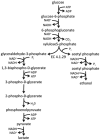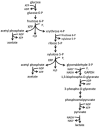Glycolysis for Microbiome Generation
- PMID: 26185089
- PMCID: PMC4507297
- DOI: 10.1128/microbiolspec.MBP-0014-2014
Glycolysis for Microbiome Generation
Abstract
For a generation of microbiologists who study pathogenesis in the context of the human microbiome, understanding the diversity of bacterial metabolism is essential. In this chapter, I briefly describe how and why I became, and remain, interested in metabolism. I then will describe and compare some of the strategies used by bacteria to consume sugars as one example of metabolic diversity. I will end with a plea to embrace metabolism in the endeavor to understand pathogenesis.
Figures







References
-
- Lipmann F. Development of the acetylation problem, a personal account. Science. 1954;120(3126):855–865. - PubMed
-
- Bentley R. From ‘reactive C2 units’ to acetyl coenzyme A: a long trail with an acetyl phosphate detour. Trends Biochem Sci. 2000;25(6):302–305. - PubMed
-
- Barak R, Eisenbach M. Acetylation of the response regulator, CheY, is involved in bacterial chemotaxis. Molecular Microbiology. 2001;40(3):731–743. - PubMed
-
- Barak R, Prasad K, Shainskaya A, Wolfe AJ, Eisenbach M. Acetylation of the Chemotaxis Response Regulator CheY by Acetyl-CoA Synthetase Purified from Escherichia coli. Journal of Molecular Biology. 2004;342(2):383–401. - PubMed
Publication types
MeSH terms
Grants and funding
LinkOut - more resources
Full Text Sources

